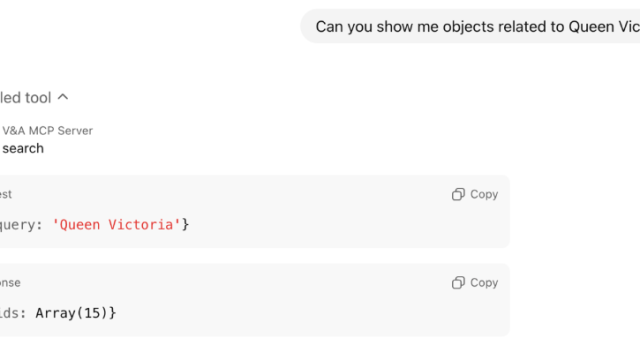Since beginning my PhD research in the V&A’s Design and Digital curatorial section, I can’t help but think about digital design objects through the eyes of imagined future people. What might someone born in, say 2050, think of these objects, and how could they best experience their use and significance?
Recently, I rediscovered a box of old mobile phones belonging to me and other family members. This accidental collection captures both personal tastes and uses, but also the rapid evolution of product design: the collection of “brick” phones, flip phones and slide phones chronicle the removal of the aerial, the introduction of the camera, the expansion of the screen, the gradual elimination of buttons and the development of touchscreen technologies. Whilst none are what we might call smartphones, each phone utilises custom-designed software and user interfaces, and each expresses the integration of mobile technologies, mobile photography, and mobile gaming in (my) daily life.

Owing to my neglect, the phones in my box are “dead”. They no longer turn on. So, whilst on some level the phones can be experienced through their physical carriers – their design, weight, the tactility of the buttons – a key experience of the phone in use is through the software and functionality of the user interface. Whilst neither the physical carrier or software can make sense without the other, the user interface is what activates the object, and it’s this dominant experience of interaction that is lost here. And despite museums looking after their objects much better than I ever did, digital objects do not survive forever, even in permanent collections. Today, the V&A and other institutions collecting digital objects like computers and mobile phones, mobile apps, videogames, websites, computer-aided design files and software-based art, are facing significant challenges in preserving and communicating experience in use against the conditions of rapid technical failure and planned obsolescence.


These concerns for interpretation and long-term care go beyond ambitions to reactivate older consumer electronics; they are of equal concern for digital works produced today, because all digital objects involving software are dependent on commercial hardware and system software programmes to run. Some also require the internet, whilst others are dependent on external databases, or proprietary software services like Adobe Flash. Because of these dependencies, collecting institutions must work with the given configurations of commercial technology – which are rapidly changing. A key concern for collecting institutions is where significant changes to these products (or their termination) may jeopardise long-term access to the works.

But beyond pragmatic concerns of technical preservation, what does it mean for continued access to museum objects to be reliant on third-party services and technological infrastructures that sit beyond the museum’s control? How can museums fulfil their duties of care for publicly owned collections in perpetuity under these conditions? And what happens when these duties aren’t fulfilled? How might the “failed” or dead digital object be understood and interpreted into the future? These are just some of the questions I’ve been exploring in my PhD research, where I investigate multiple forms of failure for digital museum objects and their implications for display, interpretation and long-term care.
Researching the collections: learning from looking back
As part of this research, I spent 3-months studying the V&A’s first born-digital and software-based artworks, which came into the collection around 2011. Artworks have different needs to consumer electronics like mobile phones, and unlike consumer electronics which, whilst not ideal, have been displayed without running, these born-digital artworks must be run to be viewed and understood. So as “live” software objects around 10-15 years old, these works have become important case studies for thinking about how to keep all types of digital objects alive in museum collections.
The works were acquired in the years following the 2009/10 exhibition Decode: Digital Design Sensations. As the V&A’s first large-scale show of immersive, interactive and kinetic works, Decode was a critical testing ground for alternative treatment and display of museum objects. More generally around this time, creative coding and software were increasingly significant for art and design practices, as were the possibilities for interaction and immersion in audience experience.


Curators recognised that capturing this more experiential moment could only be done through collecting software itself, however, collecting software in museums was uncommon and unfamiliar. The curators’ approach was therefore highly innovative, but experimentation was balanced with risk and the museum’s duty to properly care for, store, and redisplay these works into the future. Consequently, screen-based works were favoured over immersive installations, as were more “simple” executable software works, which are understood to not need other software programmes or the internet to run.

Today, these objects are artefacts of innovation in the museum. Indeed, having them in the collection is the only reason I can do this research. But some are also presenting several functionality issues due to technological malfunction and rapid obsolescence. To better understand why, and to anticipate future failure points, I focussed my study on four key works: Ernest Edmonds’ Shaping Form 14/5/2007; Random International’s Study for a Mirror; Casey Reas’ Process 18 (Software 3); and Daniel Brown’s On Growth and Form.
With each, I analysed their past procedures for collecting, histories of display, storage and care interventions against their conditions and functionality today. With the longer-range insight provided by these works, I’ve developed evidence-based recommendations for changes to working practices to better support the care of these and similar works across the digital collections. But what exactly are these problems?
Hardware failure and the issue with dependencies
Casey Reas’ Process 18 and Daniel Brown’s On Growth and Form are executable file-based works, meaning they are understood to not be reliant on other programmes or the internet to work. Whilst each requires display equipment (a computer and display screen) to run, the museum object is understood as the digital files alone. But in reality, these objects are not as “contained” as museums might hope, because even executable software will have been programmed for specific commercial hardware models and proprietary system software versions – this is often called a “period-specific technical environment”. So, whilst it is often assumed that executable files will run on different computers into the future, this is rarely the case. Changes to computer hardware, for example, Apple’s recent change from Intel to M1 Chip processors in their Mac computers, can cause subsequent compatibility issues. These changes and their implications can be difficult to predict, and my research has demonstrated how dependencies on specific hardware and system software versions often don’t reveal themselves until years after the work’s creation and acquisition.


In contrast, both Ernest Edmonds’ Shaping Form and Random International’s Study for a Mirror are understood as hardware-bound: the hardware on which the software depends is “in-built” as a sculptural element of the work. Yet, this can also present its own problems, as nothing lasts forever – even in a museum. Commercial hardware has a notably short lifespan within the context of museum collections and is often strategically unrepairable. Older computers with the appropriate operating system versions are also increasingly difficult to source, but even if museums were to stockpile hardware at the time of acquisition, its future functionality cannot be guaranteed. Unlike most museum objects for which long-term physical storage in carefully controlled conditions is ideal, computing hardware is not designed to remain switched off without network connectivity and regular use. The risk presented by dependencies therefore becomes tying the lifespan of the work to that of display equipment, even when it is not deemed a significant part of the original object.

But this idea of significance presents its own challenges beyond that of functionality. In the second post of this series, I will discuss how failure poses curatorial problems as much as conservation ones. I’ll also introduce some different strategies for postponing failure, and signpost where this research is taking me next.


Where do you see the old and the new technology going forward? How will people remember how to use the old technology like the phones when no longer relevant. The future of technology has replaced magic.